Tokyo Vacation Help
I'm going to Tokyo for the first time from Oct. 31-Nov. 9 & I was wondering if anyone had any tips & tricks for my first trip to the land of the rising sun. Cool places to go & see for a gamer is a plus. I created a Japan folder on my iPhone's Photos section with gif images to help me out while I'm there. I posted the GIFs if anyone else is planning a trip there & might need some help.
There are a couple of things that I need to fill in on Phrases 3-4.
Is there is anyone out there with Japanese language skills?
I need to know how to say, "I'm allergic to shellfish."
What I found was, "Watashi wa _______ arerugii desu." which is, "I'm allergic to _____."
Another phrase I'd like to know is:
"Two Sapporo's Please."
Also, how do you make an international phone call from Tokyo to the U.S and can I make these calls with my laptop using skype?
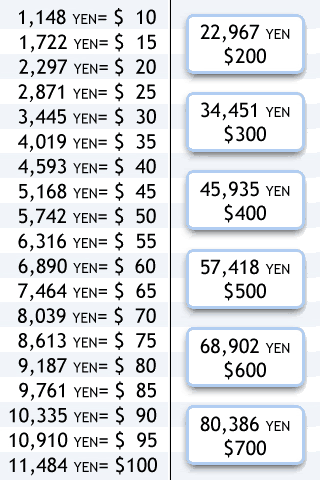
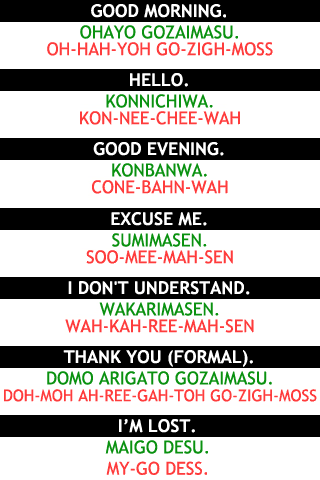
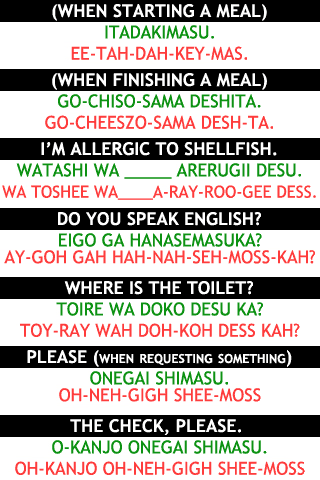
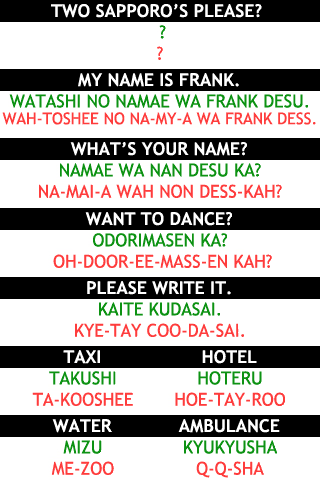
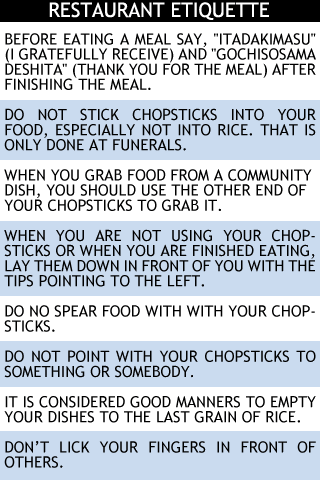

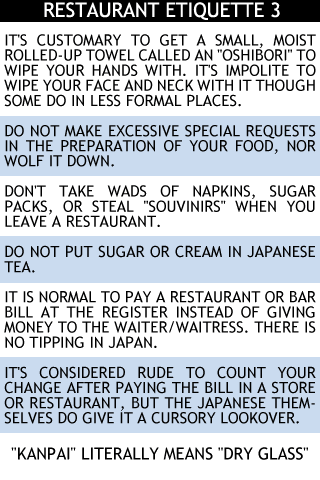
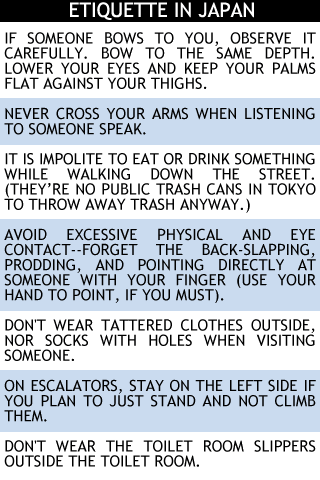
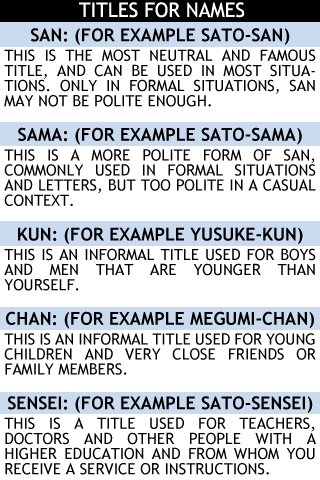
There are a couple of things that I need to fill in on Phrases 3-4.
Is there is anyone out there with Japanese language skills?
I need to know how to say, "I'm allergic to shellfish."
What I found was, "Watashi wa _______ arerugii desu." which is, "I'm allergic to _____."
Another phrase I'd like to know is:
"Two Sapporo's Please."
Also, how do you make an international phone call from Tokyo to the U.S and can I make these calls with my laptop using skype?









Comments
I just ran across your post. I'm happy to help out. What part of Japan will you be visiting? I lived there for nine years so I have some experience with this.
Below are some comments I wrote for a friend who recently visited there followed by some links we put together for him.
I'll check with my wife later for a way to say you are allergic to shellfish. My guess is that there is not a catch-all term like we have in English. You may have to list several things like shrimp, oysters, clams, ...
I have no idea about skype. I don't use it now and it didn't exist when was in Japan. You can make an international call from most any public phone. The grey phones are OK. There should be some instructions about any prefix you need to dial international. The US country code is 1.
I say grey phone because Japan has color coded public phones. This is mostly of historical interest. However, there are probably still a number of pink phones in restaurants or hotel lobbies. These cannot be used for overseas calls.
I left Japan in 2003. At the time public phones were rapidly disappearing since everyone has a cell phone.
To order a beer it depends on where you are. At most restaurants they only serve one brand of beer so you just need to say "biiru onegaishimasu" and maybe hold up two fingers. In a shop you could say "sapporo futatsu onegaishimasu". If you are in a drinking place and want to sound like a pro you could try "Oneisan, daijoki nishoku onegaishimasu." That is a way to ask the young lady to bring you two giant draft beers. These are often 750cc to 1000cc.
http://blog.e-otegami.net/beer123/image/daijokki.jpg
It is a little complicated because in Japanese counting is very complicated. Almost every number is associated with a counting word. Kind of like in English we don't just say "give me two socks", we say "give me two pair of socks." There is no way you can learn this in a short time.
However, as you are a foreigner most people will cut you some slack and you can muddle through with holding up two or three fingers when asking for something. If you are trying to learn words then you can use hitotsu, futatsu, mitsu, etc. To form the numbers six through nine open one hand and press the appropriate number of fingers into your open palm with the other had. For example, to indicate seven open one hand and press two fingers into your palm.
To indicate you don't have something or some other similar negative meaning cross you arms in an X pattern. In general, X means no (absent, broken, wrong) and O means yes (present, OK, working, good).
The most important word to learn is "domo." It means nothing and everything. It is like social lubrication. When you might say thank you or please or excuse me or many other situations you can just say domo. Maybe you can first say arigatou then as the conversation goes on you can start repeating "domo."
Another one is "sugoi." It is used a lot to express astonishment. Kind of like we use "wow", "really!", "amazing", etc. You'll hear it a lot.
Another is "ne" (nay). Often the end of a sentence is punctuated with this. It just adds emphasis. Kind of like "you know" in English.
If you'll be traveling anywhere outside Tokyo you'll probably want to get a Japan Rail Pass. It costs a few hundred dollars for a two week pass. That is about the price of one round trip to Osaka. Then the rest of your travel is free.
http://www.kintetsu.com/jrpass/?gcli...FREDWAodpT783A
Regards,
John
Tokyo:
In Tokyo Asakusa is interesting. It has a large shrine and a long walkway up to the shrine filled with little outdoor vendors. It very close to Akihabara, the electronics district. These are also not too far from the Emperor's Palace and Ginza. Ginza is the district with the huge department stores.
From Tokyo you could take a one day bus tour to Mt. Fuji.
From Tokyo you could take a one day train tour to Nikko. Probably an overnight stay would be less hectic. This set of shrines honors the last shogun. It is ornate and colorful. The scenery is nice as it is set in the mountains.
Ueno Park has lots of museums. The Tokyo National Museum is a huge structure with lots of cultural Japanese items.
http://www.planetware.com/tokyo/ueno...jpn-kn-tnm.htm
Shibuya is on the west side of Tokyo. It is where the young kids hang out. It is an interesting area to walk through just to people watch and window shop. Harajuku is nearby. Another nice place to people watch and window shop.
You might want to take in a Kabuki show. These go on for hours but you can get a ticket for a shorter duration (30 minutes or an hour). These are stage plays with colorful costumes and sets and live music. There is a famous theater near Ginza.
Also, through a travel agent you can probably find a Geisha show or similar cultural presentation. They have them in both Kyoto and Tokyo. Kyoto would be better.
Kyoto:
Sanju-Sangen-do is an interesting temple. Inside are something like a thousand statues of Buddha culminating in one large statue in the center. They used to have archery tournaments here indoors. Because the roof is really low it took a powerful archer to shoot an arrow the length of the building and hit the target without hitting the ceiling.
Kiyomizu-Dera is interesting. It is a large temple built very high on a lattice of logs. Lots of shops on the road leading to the entrance. Everyone who goes to Kyoto visits here.
Kinkaku-ji is a very nice looking building surrounded by a pond. The interesting thing is that the whole building is covered in gold leaf. Pretty amazing.
Ryo-an-ji: very near Kinkaku-ji. Famous for the rock garden. There are a dozen or so large rocks set in a garden where the ground is covered with small gravel. Every day the monks rake the gravel so it has many straight lines left from the raking.
Heian-jingu: Large place with stunning red highlights.
Nara:
Daibutsu: Huge wooden building with giant statue of the Buddha.
Sight-seeing: http://www.japanwelcomesyou.com/cssweb/
http://www.tokyoessentials.com/, http://www.japan-guide.com/e/e623.html
Tokyo
Asakusa: http://wikitravel.org/en/Tokyo/Asakusa, http://www.asakusa-e.com/index_e.html
Ginza: http://www.jref.com/practical/ginza.shtml
Akihabara
Shinjuku: http://www.japan-guide.com/e/e3011.html, http://www.tokyoessentials.com/shinjuku.html
Imperial Palace: http://www.japan-guide.com/e/e3017.html
kabuki: http://www.shochiku.co.jp/play/kabukiza/theater/, http://www.kabuki-za.co.jp/english/program.html#0609
Near Tokyo
Kamakura: http://www.city.kamakura.kanagawa.jp/english/index.htm, http://www.japan-guide.com/e/e2166.html
Nikko: (one to two hours from Tokyo)
Tosyo-gu Shrine: http://www.nikko-jp.org/english/index.html
http://wikitravel.org/en/Nikko
Kyoto, http://raku.city.kyoto.jp/sight_e.phtml
Sanju-Sangen-do: http://www.japan-guide.com/e/e3900.html, http://www.taleofgenji.org/sanjusangendo.html
Kiyomizu-Dera: http://www.japan-guide.com/e/e3901.html
Kinkaku-ji Temple: http://www.japan-guide.com/e/e3908.html, http://www.yamasa.org/japan/english/...kinkakuji.html
Ryo-an-ji: http://www.ryoanji.jp/, http://www.yamasa.org/japan/english/...o/ryoanji.html
Heian-jingu Shurine: http://www.heianjingu.or.jp/index_e.html
Nara, Daibutsu (Biggest Buddhist Statue in the world)
http://narashikanko.jp/english/menu/menu_2.html
http://www.narakotsu.co.jp/teikan/te...an/tour_1.html
Hi,
I just ran across your post. I'm happy to help out. What part of Japan will you be visiting? I lived there for nine years so I have some experience with this.
Below are some comments I wrote for a friend who recently visited there followed by some links we put together for him.
I'll check with my wife later for a way to say you are allergic to shellfish. My guess is that there is not a catch-all term like we have in English. You may have to list several things like shrimp, oysters, clams, ...
I have no idea about skype. I don't use it now and it didn't exist when was in Japan. You can make an international call from most any public phone. The grey phones are OK. There should be some instructions about any prefix you need to dial international. The US country code is 1.
I say grey phone because Japan has color coded public phones. This is mostly of historical interest. However, there are probably still a number of pink phones in restaurants or hotel lobbies. These cannot be used for overseas calls.
I left Japan in 2003. At the time public phones were rapidly disappearing since everyone has a cell phone.
To order a beer it depends on where you are. At most restaurants they only serve one brand of beer so you just need to say "biiru onegaishimasu" and maybe hold up two fingers. In a shop you could say "sapporo futatsu onegaishimasu". If you are in a drinking place and want to sound like a pro you could try "Oneisan, daijoki nishoku onegaishimasu." That is a way to ask the young lady to bring you two giant draft beers. These are often 750cc to 1000cc.
http://blog.e-otegami.net/beer123/image/daijokki.jpg
It is a little complicated because in Japanese counting is very complicated. Almost every number is associated with a counting word. Kind of like in English we don't just say "give me two socks", we say "give me two pair of socks." There is no way you can learn this in a short time.
However, as you are a foreigner most people will cut you some slack and you can muddle through with holding up two or three fingers when asking for something. If you are trying to learn words then you can use hitotsu, futatsu, mitsu, etc. To form the numbers six through nine open one hand and press the appropriate number of fingers into your open palm with the other had. For example, to indicate seven open one hand and press two fingers into your palm.
To indicate you don't have something or some other similar negative meaning cross you arms in an X pattern. In general, X means no (absent, broken, wrong) and O means yes (present, OK, working, good).
The most important word to learn is "domo." It means nothing and everything. It is like social lubrication. When you might say thank you or please or excuse me or many other situations you can just say domo. Maybe you can first say arigatou then as the conversation goes on you can start repeating "domo."
Another one is "sugoi." It is used a lot to express astonishment. Kind of like we use "wow", "really!", "amazing", etc. You'll hear it a lot.
Another is "ne" (nay). Often the end of a sentence is punctuated with this. It just adds emphasis. Kind of like "you know" in English.
If you'll be traveling anywhere outside Tokyo you'll probably want to get a Japan Rail Pass. It costs a few hundred dollars for a two week pass. That is about the price of one round trip to Osaka. Then the rest of your travel is free.
http://www.kintetsu.com/jrpass/?gcli...FREDWAodpT783A
Regards,
John
Tokyo:
In Tokyo Asakusa is interesting. It has a large shrine and a long walkway up to the shrine filled with little outdoor vendors. It very close to Akihabara, the electronics district. These are also not too far from the Emperor's Palace and Ginza. Ginza is the district with the huge department stores.
From Tokyo you could take a one day bus tour to Mt. Fuji.
From Tokyo you could take a one day train tour to Nikko. Probably an overnight stay would be less hectic. This set of shrines honors the last shogun. It is ornate and colorful. The scenery is nice as it is set in the mountains.
Ueno Park has lots of museums. The Tokyo National Museum is a huge structure with lots of cultural Japanese items.
http://www.planetware.com/tokyo/ueno...jpn-kn-tnm.htm
Shibuya is on the west side of Tokyo. It is where the young kids hang out. It is an interesting area to walk through just to people watch and window shop. Harajuku is nearby. Another nice place to people watch and window shop.
You might want to take in a Kabuki show. These go on for hours but you can get a ticket for a shorter duration (30 minutes or an hour). These are stage plays with colorful costumes and sets and live music. There is a famous theater near Ginza.
Also, through a travel agent you can probably find a Geisha show or similar cultural presentation. They have them in both Kyoto and Tokyo. Kyoto would be better.
Kyoto:
Sanju-Sangen-do is an interesting temple. Inside are something like a thousand statues of Buddha culminating in one large statue in the center. They used to have archery tournaments here indoors. Because the roof is really low it took a powerful archer to shoot an arrow the length of the building and hit the target without hitting the ceiling.
Kiyomizu-Dera is interesting. It is a large temple built very high on a lattice of logs. Lots of shops on the road leading to the entrance. Everyone who goes to Kyoto visits here.
Kinkaku-ji is a very nice looking building surrounded by a pond. The interesting thing is that the whole building is covered in gold leaf. Pretty amazing.
Ryo-an-ji: very near Kinkaku-ji. Famous for the rock garden. There are a dozen or so large rocks set in a garden where the ground is covered with small gravel. Every day the monks rake the gravel so it has many straight lines left from the raking.
Heian-jingu: Large place with stunning red highlights.
Nara:
Daibutsu: Huge wooden building with giant statue of the Buddha.
Sight-seeing: http://www.japanwelcomesyou.com/cssweb/
http://www.tokyoessentials.com/, http://www.japan-guide.com/e/e623.html
Tokyo
Asakusa: http://wikitravel.org/en/Tokyo/Asakusa, http://www.asakusa-e.com/index_e.html
Ginza: http://www.jref.com/practical/ginza.shtml
Akihabara
Shinjuku: http://www.japan-guide.com/e/e3011.html, http://www.tokyoessentials.com/shinjuku.html
Imperial Palace: http://www.japan-guide.com/e/e3017.html
kabuki: http://www.shochiku.co.jp/play/kabukiza/theater/, http://www.kabuki-za.co.jp/english/program.html#0609
Near Tokyo
Kamakura: http://www.city.kamakura.kanagawa.jp/english/index.htm, http://www.japan-guide.com/e/e2166.html
Nikko: (one to two hours from Tokyo)
Tosyo-gu Shrine: http://www.nikko-jp.org/english/index.html
http://wikitravel.org/en/Nikko
Kyoto, http://raku.city.kyoto.jp/sight_e.phtml
Sanju-Sangen-do: http://www.japan-guide.com/e/e3900.html, http://www.taleofgenji.org/sanjusangendo.html
Kiyomizu-Dera: http://www.japan-guide.com/e/e3901.html
Kinkaku-ji Temple: http://www.japan-guide.com/e/e3908.html, http://www.yamasa.org/japan/english/...kinkakuji.html
Ryo-an-ji: http://www.ryoanji.jp/, http://www.yamasa.org/japan/english/...o/ryoanji.html
Heian-jingu Shurine: http://www.heianjingu.or.jp/index_e.html
Nara, Daibutsu (Biggest Buddhist Statue in the world)
http://narashikanko.jp/english/menu/menu_2.html
http://www.narakotsu.co.jp/teikan/te...an/tour_1.html
Thanks for all of the info neutrino23. My friend & I are going to be in Tokyo from October 31-Nov 9th. We're staying at Keio Plaza Hotel near Shinjuku Station. Some questions though:
We will probably be checking out the sites around Shinjuku Station, Harajuku Station & Shibuya Station. Do these stations have only subways or trains or a combination of both?
How much does it typically cost to ride the subway & trainlines?
Do the trains & subways run 24/7 or do they close at a certain time?
What's the correct way to say Shinjuku Station or Shibuya Station in Romaji?
My friend & I are going on the Mt. Fuji and Hakone Tour. We leave from our hotel but they will drop us off at the Tokyo Train Station at the end of the tour. What would be the easiest way to get back to Shinjuku Station from the Tokyo Train Station?
Are taxi's expensive in Tokyo? Do they go by mileage or by the amount of time sitting in the cab?
Besides the phrase, "I am allergic to shellfish" do you know if your wife also knows "I have asthma."?
What are the extra numbers that I need to know to make an International call from Tokyo to the United States? (What would I have to dial before the (414) 123-4567)
Thanks for all of the info neutrino23. My friend & I are going to be in Tokyo from October 31-Nov 9th. We're staying at Keio Plaza Hotel near Shinjuku Station. Some questions though:
We will probably be checking out the sites around Shinjuku Station, Harajuku Station & Shibuya Station. Do these stations have only subways or trains or a combination of both?
How much does it typically cost to ride the subway & trainlines?
Do the trains & subways run 24/7 or do they close at a certain time?
What's the correct way to say Shinjuku Station or Shibuya Station in Romaji?
My friend & I are going on the Mt. Fuji and Hakone Tour. We leave from our hotel but they will drop us off at the Tokyo Train Station at the end of the tour. What would be the easiest way to get back to Shinjuku Station from the Tokyo Train Station?
Are taxi's expensive in Tokyo? Do they go by mileage or by the amount of time sitting in the cab?
Besides the phrase, "I am allergic to shellfish" do you know if your wife also knows "I have asthma."?
What are the extra numbers that I need to know to make an International call from Tokyo to the United States? (What would I have to dial before the (414) 123-4567)
The Keio Plaza is a very nice place. I'm Jealous. I used to live five or six miles from there. The whole area is interlaced with subways and trains. It is pretty amazing.
The simplest way to get to Harajuku and Shibuya is by train from Shinjuku station. It probably costs about 200 yen. It's probably more now. The price varies with distance. The smallest price used to be about 110 or 120 yen and you could go pretty far for about 250 or 300 yen.
To buy a ticket you arrive at the station then find your destination in a large map posted on the wall. Next to the name of the destination is a price. That is the charge to your destination. Then you buy a ticket for that destination. You can also just buy the cheapest ticket then settle up when you arrive. There will be a machine (probably several) where you can stick your ticket in the slot and then a message appears saying how much you have to pay extra.
You can also buy prepaid cards. These will cost anywhere from 500 yen to maybe 3,000 or 5,000 yen. They are very easy to use. As you enter the station you just stick the card in a slot and then retrieve it. At the destination you repeat the process and the amount of your fare is deducted from the card. The amount deducted and the amount remaining are printed on the card. There may now be even more methods to pay train fare. The Japanese are very aggressive about implementing new technologies. The locals can sometimes pay with their cell phones and they have some long term cards that are activated by radio. They just have to wave them over the entrance gate. As I pointed out earlier, if you have a Japan Rail Pass you don't have to pay for local travel on the main train lines. You still have to pay for travel on the private lines and subways. Subways and trains are separate so if you have a pass of some sort for one it doesn't work on the other.
When you are inspecting the map to see the price you also want to identify the train line and the direction you want to travel in. For example, to go to Harajuku from Shinjuku you would take the Yamanote line. When you find that you have to figure out which way to go. From the map you would see that Yoyogi is the next stop from Shinjuku in the direction of Harajuku so you would find the Yamanote line then look for the direction going to Yoyogi. They sometimes also indicate some other main stations in the direction of the train.
If you overshoot your destination you can get off the train and get on a train going the other direction without paying any extra. You don't have to pay till you leave the station.
The trains and subways mostly start around 5:00AM or 6:00AM and run till midnight or 1:00AM. This can vary quite a bit so you need to be careful. The taxi fares go up quite a bit after the trains stop running.
The word for station is eki. So you would say Shinjuku eki or Tokyo eki.
From Tokyo station you would take the Chuo line to Shinjuku. It is about a 25 minute ride. Make sure you have a good map of the area around the train station. Shinjuku station is huge. Make sure you exit towards the west. NishiShinjuku. If you get out on the east side it could take an hour to find your way to the hotel. Even from the west exit it is a good ten minute walk to the hotel. If it is raining you can walk underground most of the way.
Shibuya and Shinjuku have lots of subway connections but I don't think there is a subway connection between them. The front desk at the Keio Plaza might be able to provide you with English train and subway maps.
Shellfish is kai in Japanese. You would say "Kai arerugii desu." Kai literally means animals with shells like clams and oysters. If you want to include shrimp you could say "kai mo, ebi mo taberaremasen. Arerugii desu." Arerugii is hard to say in Japanese. You could just say "taberaremasen" which means "I can't eat". You could just point to something and say taberaremasen. Colloquial Japanese is very compact. You don't have to speak in full sentences.
To say "I have asthma" say "Zensoku ga arimasu."
Taxis are kind of expensive. It depends on your budget. To get into a cab costs 660 yen. That will take you 2km. After that charges are added by distance. If you are taking a cab which has been lined up at a train station for a long time they get a little peeved if you are going a short distance. If you just flag one down on the road they usually don't mind short trips. You probably will need written directions to communicate with them. It is a good idea to carry a card from the hotel so you can get back there in an emergency or if you get lost.
This website explains how to make an international call.
http://accessible.jp.org/tokyo/en/useful/call.html
Using KDD you would dial
011 1 (area code) (phone number)
011 gets overseas long distance
1 is the code for the US
I did a quick scan of the Keio Plaza website and it seems you can get a broadband connection in the room.
Hope you have a good time. It certainly should be interesting.